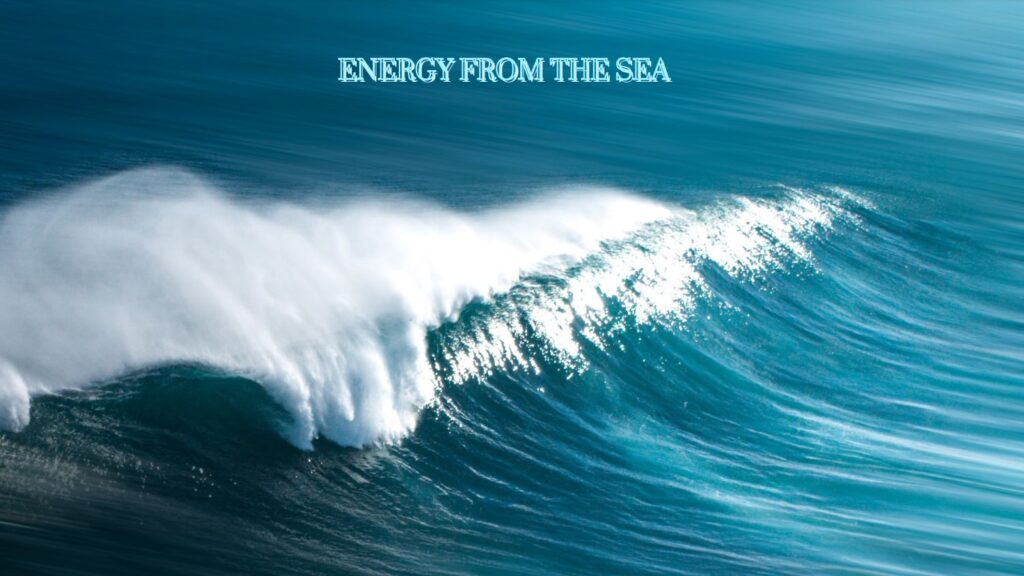Sea Energy: Seawater covers more than 70% of the Earth’s surface and for decades has been an attractive target for the production of renewable energy sources. According to expert estimates, waves alone produce 32,000 terawatt hours of natural energy annually, while global energy needs in 2019 were around 23,000 terawatt hours. If one considers the power of currents, tides, and thermal energy, our planet’s seas and oceans represent an inexhaustible energy source that is constantly in motion.
The first attempt to exploit marine energy dates back to 1799, when Monsieur Girard, a French scientist, and his son were the first people to use waves to generate power. Since then, until 1970, there have been many individual attempts to exploit energy from the sea. In 1970, however, after the oil crisis, the need to discover new sources of power was now imperative.
Forms of Ocean Energy
The oceans represent a vast and largely untapped energy source from surface waves, fluid flow, salt content, and thermal energy.
Marine energy harnessed in international waters includes projects that use the following provisions:
- Converters of wave energy in open coastal areas with significant waves.
- Tidal energy generators located in coastal areas and estuaries.
- Steam turbines in fast-flowing rivers.
- Generators of ocean currents in areas with strong sea currents.
- Ocean thermal energy converters in deep tropical waters.
Marine power generation
Strong ocean currents are produced by a combination of temperature, wind, salinity, bathymetry, and the rotation of the Earth. The sun is the primary driving force, causing winds and temperature differences. Because there are only minor variations in current speed and location of currents, without changes in direction, ocean currents may be suitable locations for energy extraction facilities such as hydroelectric generators.
The Thermal Energy of the Oceans
Water typically varies with temperature. At the surface, it is heated by direct sunlight, in contrast to the deeper depths where sunlight cannot penetrate. This temperature variation is more significant in tropical waters, making this technology more suitable for application in such geographic locations. A liquid that evaporates can often be driven into a turbine to produce electricity or desalinated water. These systems can be either open, closed, or hybrid, which we analyse below.
Tidal Energy
Energy from moving bodies of water is a popular form of hydroelectric power generation. Tidal electricity production includes three primary forms, namely: tidal energy from currents, dam tidal energy, and dynamic tidal energy, which we will see in more detail below.

Wave Energy – Sea Energy
Solar energy from the sun creates temperature differences that lead to the wind. The interaction between the wind and the surface of the water creates waves, which are more extensive when there is a greater distance to make them. Wave potential energy is greatest between 30° and 60° latitude, in both hemispheres, due to global wind direction. When evaluating wave energy as a type of technology, it is essential to distinguish between the four most common approaches: absorber-point buoys, surface attenuators, pulsating water columns, and wave-skimming devices.
Research for the Future
A triboelectric nanogenerator (TENG) can generate electricity from any form of mechanical energy. For this reason, various strategies have been developed to exploit mechanical energy when it appears in contact or sliding of materials. Below is a description of some of the more popular techniques for building TENG generators and schematic diagrams of voltages and currents as they develop.
According to expert estimates, waves alone produce 32,000 terawatt hours of natural energy annually, while global energy needs in 2019 were around 23,000 terawatt hours. In most floating systems, so-called triboelectric nanogenerators (TENG) are used.
Floating Systems of Energy Production
The Floating Systems of energy production from the sea have various applications for the marine environment and are essential to Blue Growth. Indicative applications include the following:
- The electricity production is for everyday use and in large infrastructures in the coastal zone (electrification in ports, industries, etc.).
- The self-supply of floating measuring stations operating in the marine environment for civil protection and national security issues.
- The energy supply to floating structures in the open sea supports vessels.
The globally innovative RES project “Floating Sea-Nrg Systems” concerns the placement of one or more hydroelectric energy production plants inside a floating tank with double walls, sinking into the sea, entering the water through a water pipe to the hydro turbine which is connected to an electric generator, electricity is generated and by utilizing the hydroponic method the water is released back into the sea without consuming energy.



